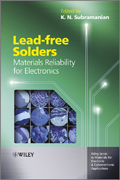
Lead-free Solders: Materials Reliability for Electronics provides a comprehensive understanding of the current state of lead-free electronic interconnects research from fundamental, applied, and manufacturing perspectives. The main thematic areas addressed include: Alloy development Composite approaches (including nanoscale reinforcements) Thermomechanical fatigue Electromigration Whisker growth Reliability under impact loading Accelerated thermal cycling Long-term reliability High temperature lead-free solders Lead-free Solders: MaterialsReliability for Electronics: Provides a comprehensive review of the current state of knowledge for implementing lead-free electronics required under recentlegislation Includes articles on alloy development, electromigration and long-term reliability Contains contributions from academic, industrial and national laboratory researchers Representing a major resource in material design for microelectronics development and manufacturing this is essential reading for Researchers in materials science and electronic/electrical engineering in both academia and industry, as well as graduate students in these fields. Physicists and chemists involved in lead-free electronics will also find this of interest. INDICE : Series Preface xv Preface xvii List of Contributors xix Thematic Area I: Introduction 1 1 Reliability of Lead-Free Electronic Solder Interconnects: Roles of Material and Service Parameters 3 K. N. Subramanian 1.1 MaterialDesign for Reliable Lead-Free Electronic Solders Joints 3 1.2 Imposed Fields and the Solder Joint Responses that Affect Their Reliability 5 1.3 Mechanical Integrity 5 1.4 Thermomechanical Fatigue (TMF) 6 1.5 Whisker Growth 7 1.6 Electromigration (EM) 7 1.7 Thermomigration (TM) 8 1.8 Other Potential Issues 8 Thematic Area II: Phase Diagrams and Alloying Concepts 11 2 Phase Diagrams and their Applications in Pb-Free Soldering 13 Sinn-wen Chen, Wojciech Gierlotka, Hsin-jay Wu, and Shih-kang Lin 2.1 Introduction 14 2.2 Phase Diagrams of Pb-Free Solder Systems 14 2.3 Example of Applications 28 2.3.1 General Applications (Melting, Solidification, Interfacial Reactions) 28 2.3.2 Effective Undercooling Reduction (Co Addition) 32 2.3.3 Unexpected Compound Formation (Sn-Ag/Cu Interfacial Reactions) 33 2.3.4 Unexpected Growth Rates (Sn-Bi/Fe and Sn-Pb/Fe) 34 2.3.5 Unexpected Melting of Solder (Sn-Sb/Ag) 36 2.3.6 Uphill Diffusion (Sn-Cu/Ni) 38 2.3.7 Limited Sn Supply (Au/Sn/Cu) 40 2.4 Conclusions 42 Acknowledgment 42 References 42 3 Phase Diagrams and Alloy Development 47 Alan Dinsdale,Andy Watson, Ales Kroupa, Jan Vrestal, Adela Zemanova, and Pavel Broz 3.1 Introduction 47 3.2 Computational Thermodynamics as a Research Tool 50 3.2.1 Concept of the Calculation of Phase Diagrams for Multicomponent Systems 50 3.2.2 Modelling of the Gibbs Energy of the System 52 3.2.3 Critical Assessment of Thermodynamic Properties 53 3.3 Thermodynamic Databases the Underlying Basis of the Modelling of Phase Diagrams and Thermodynamic Properties, Databases for Lead-Free Solders 53 3.3.1 Creation of the Thermodynamic Databases 54 3.3.2 ThreeConditions of Consistency 54 3.3.3 Specialized Databases for the Modelling ofThermodynamic Properties of Systems Relevant for Lead-Free Solders 56 3.4 Application of the SOLDERS Database to Alloy Development 59 3.4.1 Modelling of Phase Diagrams and Thermodynamic Properties 60 3.4.2 Modelling of Other Properties 67 3.5 Conclusions 70 References 70 4 Interaction of Sn-based Solders with Ni(P) Substrates: Phase Equilibria and Thermochemistry 73 Clemens Schmetterer,Rajesh Ganesan, and Herbert Ipser 4.1 Introduction 74 4.2 Binary Phase Equilibria 75 4.2.1 Literature Overview 75 4.2.2 New Experimental Results 79 4.3 Ternary Phase Equilibria Ni-P-Sn 87 4.3.1 Literature Overview 87 4.3.2 Experimental Results 88 4.4 Thermochemical Data 96 4.4.1 Literature Overview 97 4.4.2 New Experimental Results 101 4.5 Relevance of the Results and Conclusion 113 Acknowledgments 115 References 115 Thematic Area III: Microalloying to Improve Reliability 121 5 Effects of Minor Alloying Additions on the Properties and Reliability of Pb-Free Solders and Joints 123 Sung K. Kang 5.1 Introduction 124 5.2 Controlling Ag3Sn Plate Formation 127 5.3 Co
- ISBN: 978-0-470-97182-6
- Editorial: John Wiley & Sons
- Encuadernacion: Cartoné
- Páginas: 528
- Fecha Publicación: 16/03/2012
- Nº Volúmenes: 1
- Idioma: Inglés
